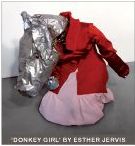|
temporarycontemporary hosts * * * Private View Thursday 16 February Contact: For more info please visit: www.grafeo.com/identikit/ |
 |
|
Mike Ballard, Marco Calí, Sergio Cruz, Sara Dell’Onze, Claire Deniau, Marcin Dudek, Francesca Galeazzi, Judy Goldhill, Esther Jervis, Lydia Maria Julien, Sophie Loss, Brendan Murphy, Maureen O’Brien, Veronica Perez Karleson, Shelley Rae, Lara Ritosa-Roberts, Joanna Salter, Cally Trench, Alvin Watt, Mary Yacoob. identikit is an exhibition of work by 20 international artists curated by Brendan Murphy and includes works by Michael Ballard, Marco Calí, Sergio Cruz, Sara Dell’Onze, Claire Deniau, Marcin Dudek, Francesca Galeazzi, Judy Goldhill, Esther Jervis, Lydia Maria Julien, Sophie Loss, Brendan Murphy, Maureen O’Brien, Veronica Perez Karleson, Shelley Rae, Lara Ritosa-Roberts, Joanna Salter, Cally Trench, Alvin Watt and Mary Yacoob. Identity is at once mutable and fragmented. It is also constantly developing. In 2006, where there appears to be no critical authority to which the production of art must answer, it is arguably the most interesting artists who respond to, and reflect, the social and cultural climate of our time. As notions of identity continue to prove impossible to define, and the British Government pushes forward with its much criticised identity card proposals, we are all challenged to question more and more the nature of identity and personal freedom. identikit suggests the attempt to build an entire picture or isolate a singular preoccupation. This, however, is not the case. As we witness constant interventions in our daily lives we are only ever afforded glimpses. As witnesses, we rarely fully understand what we see, and as artists, we are rarely able to fully describe what it is that we have seen. What is most compelling about the works in this exhibition is the diversity of materials, strategy, and process. These hybrid practices that draw on memories, dreams, interventions, and role-play as much as they do on social and religious traditions or conventions, demonstrate how any form of consensus remains elusive. The most we can do is catch a glimpse of the wealth and complexity of the components which go together to form individual identities and experience. We are encouraged to fill in the gaps ourselves. |
|
